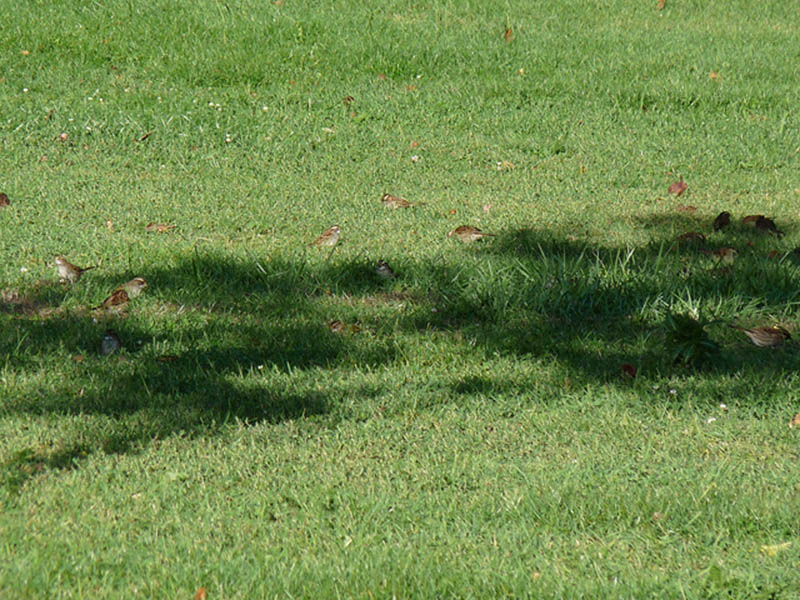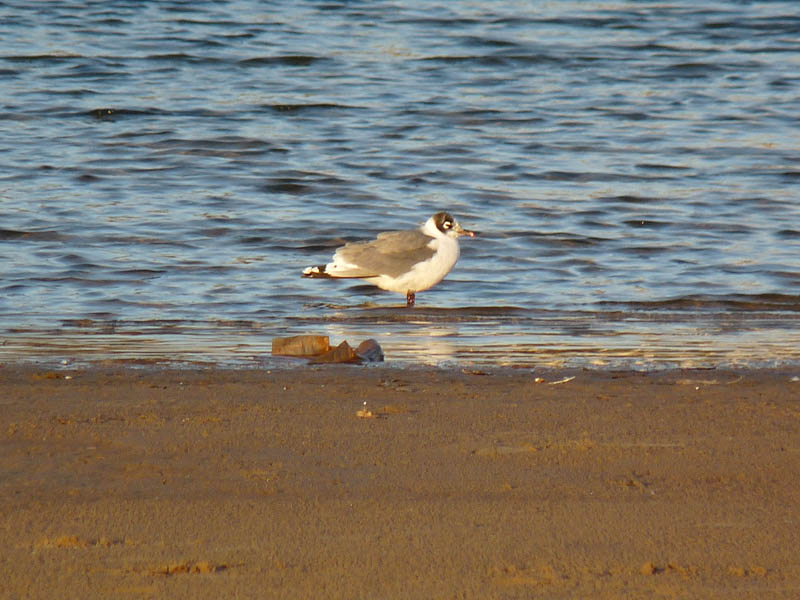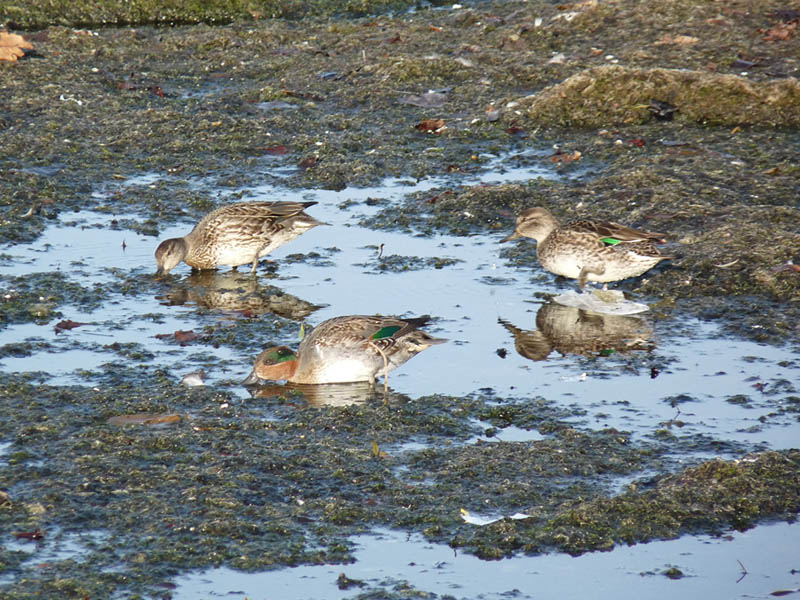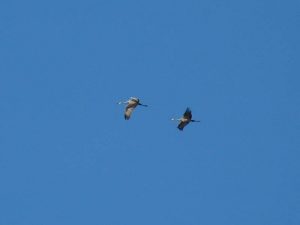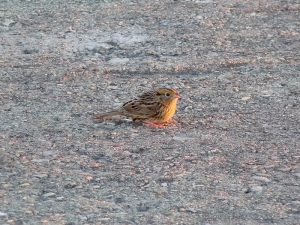October means sparrows at Montrose and Montrose is a great location to see a large variety of them. You’ll have fun sorting through the flocks of White-throated and White-crowned Sparrows, and uncommon species like Nelson’s, Le Conte’s, and Harris’s are regular. Nelson’s are best in the marshes in the Dunes known as pannes. Le Conte’s can be found almost anywhere where there’s grass but I’ve had good luck with them in the meadow southeast of the Magic Hedge. Look for Harris’s while you’re sifting through the White-throated and White-crowned Sparrow flocks.
Tag Archives: Le Conte’s Sparrow
Montrose Unleashed, Part II, May 1, 2018
I took today off in anticipation of what I expected to be a great day of birding at Montrose Point in Chicago. It was fantastic, exceeding even my own optimistic expectations. The southwest winds brought in a ton of migrants – I’ve lost track of all the FOS’s I snatched up today. A review of eBird reports from Montrose shows about 125 species reported from about 20 submissions. This will probably go down as one of the best days this spring. My highlights include
Baird’s Sandpiper – Probably the same bird from yesterday. A very good spring bird for us.
Willet – 2
Franklin’s Gull – Older immature bird on the beach
All 6 regularly occurring swallows
All Catharus thrushes plus Wood Thrush. Excellent numbers of Swainson’s Thrushes.
19 species of warblers highlighted by Pine, Hooded, Blackpoll, Chestnut-sided, and Blackburnian
Grasshopper Sparrow – 1
Le Conte’s Sparrow – 1
Dickcissel – 1
Bobolink – 1
Orchard Oriole – 1
Rusty Blackbird – 1
I ended up with 102 species for the day, only the fourth time I’ve cracked the century mark at Montrose in the 30+ years of been birding the place.
eBird Checklist
https://ebird.org/view/checklist/S45143092
Short-eared Owl, Northern Shrike, Le Conte’s Sparrows, and Black-throated Blue Warbler, October 21, 2017
Montrose wasn’t quite as birdy (for me) as on Thursday, but it was still pretty good today, October 21. I ended up with 47 species in a little over 2 hours of effort, highlighted by
Baird’s Sandpiper – the continuing juvenile
Semipalmated Sandpiper – the continuing molting first cycle bird
Short-eared Owl – 1 in the dunes
Northern Shrike – 1 in the dunes
Black-throated Blue Warbler – female near the Magic Hedge
Le Conte’s Sparrow – 2 in the dunes
The Northern Shrike was my bird-of-the-day; I haven’t seen one at Montrose in a few years. Maybe this will be a flight year for them. The algae mat continues at the east end of the beach, and it continues to attract shorebirds and ducks. The dominant passerine was Swamp Sparrow.
eBird Checklist
https://ebird.org/ebird/view/checklist/S40043108
Short-eared Owl, Nelson’s and Le Conte’s Sparrows, October 19, 2017
I spent a couple hours birding Montrose this morning, October 19, and it was inexplicably good. By inexplicable I mean no cold front passed the night before and no cold front is expected to pass until next week, so I don’t know why today was so productive. The increase in sparrow activity compared to yesterday was noticeable – today may have been “the” sparrow day of the fall at Montrose for me. I ended up with 54 species, highlighted by
Black-crowned Night-Heron – 3 immature birds flying around the point. Getting late.
Baird’s Sandpiper – the continuing juvenile bird
Semipalmated Sandpiper – the continuing first cycle bird
Franklin’s Gull – 2 first cycle birds
Short-eared Owl – 2 in the dunes
Le Conte’s Sparrow – 2, 1 in the dunes, the other in the native planting area
Nelson’s Sparrow – 1 in the native planting area
The algae mat at the east end of the beach continues to attract good numbers of shorebirds and ducks (where was this mat 2 months ago when we needed it?)
eBird Checklist
http://ebird.org/ebird/view/checklist/S40010343
Red-throated Loons, Sandhill Cranes, Le Conte’s Sparrow, and Western Meadowlark, April 1, 2017
I spent an enjoyable morning at Montrose today, April 1. It was on the chilly side, but the sun was out and the birding was productive. I ended up with 46 species in about 3 hours, highlights including:
White-winged Scoter – group of 9 flying north
Red-throated Loon – group of 4 flying north
Common Loon – 6 flying north
Sandhill Crane – 2 flying south over the point
Bonaparte’s Gull – group of 9 flying north
Le Conte’s Sparrow – 1 in the dunes
Western Meadowlark – 1, seen and heard singing in the dunes
The bird of the day goes to the Western Meadowlark. I’ve only had a couple WEMEs in my 30+ years birding Montrose, so this is a pretty good bird for me. The Sandhill Cranes and Le Conte’s Sparrow were nice bonus birds. Link to my eBird checklist below.
eBird Checklist
http://ebird.org/ebird/view/checklist/S35609386
Le Conte’s Sparrow, November 7, 2016
I’ve had some weird birding experiences, but this morning’s encounter with an out of place Le Conte’s Sparrow has to rank as one of the strangest. I was walking on the fishing pier when about two-thirds of the way out I noticed a small bird standing on the concrete just ahead of me. If you’ve been to the fishing pier you know that it doesn’t offer much in the way of cover, plus it’s surrounded by Lake Michigan. Not the most desirable habitat for a migrating passerine. The bird was holding perfectly still; if I wasn’t looking down I may have stepped on it. At first glance I thought it was a Golden-crowned Kinglet, but upon closer scrutiny it turned out to be a Le Conte’s Sparrow! There, on the concrete, exposed and in the open, was a bird known for its skulking habits, a bird that can be frustratingly difficult to see well. It was alert and seemed healthy, so I’m guessing it came in off the lake after a night of migration and plunked down on the pier because that was the first “land” it encountered. I’m also guessing the 2 Peregrine Falcons patrolling the beach were why it was holding so still and why it was reluctant to fly. I took a few pics before turning around and walking back.
eBird Checklist
http://ebird.org/ebird/view/checklist/S32415165

